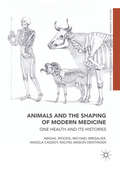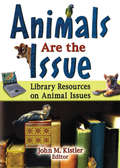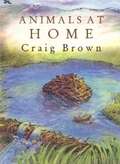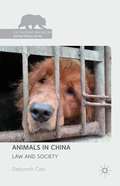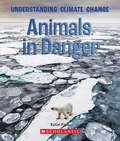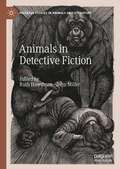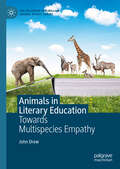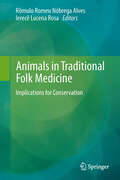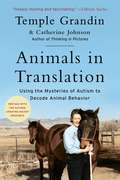- Table View
- List View
Animals and the Moral Community: Mental Life, Moral Status, and Kinship
by Gary SteinerGary Steiner argues that ethologists and philosophers in the analytic and continental traditions have largely failed to advance an adequate explanation of animal behavior. Critically engaging the positions of Marc Hauser, Daniel Dennett, Donald Davidson, John Searle, Martin Heidegger, and Hans-Georg Gadamer, among others, Steiner shows how the Western philosophical tradition has forced animals into human experiential categories in order to make sense of their cognitive abilities and moral status and how desperately we need a new approach to animal rights. <P><P>Steiner rejects the traditional assumption that a lack of formal rationality confers an inferior moral status on animals vis-à-vis human beings. Instead, he offers an associationist view of animal cognition in which animals grasp and adapt to their environments without employing concepts or intentionality. Steiner challenges the standard assumption of liberal individualism according to which humans have no obligations of justice toward animals. Instead, he advocates a "cosmic holism" that attributes a moral status to animals equivalent to that of people. Arguing for a relationship of justice between humans and nature, Steiner emphasizes our kinship with animals and the fundamental moral obligations entailed by this kinship.
Animals and the Shaping of Modern Medicine: One Health and its Histories (Medicine and Biomedical Sciences in Modern History)
by Angela Cassidy Abigail Woods Michael Bresalier Rachel Mason DentingerThis book is open access under a CC BY 4. 0 license. This book breaks new ground by situating animals and their diseases at the very heart of modern medicine. In demonstrating their historical significance as subjects and shapers of medicine, it offers important insights into past animal lives, and reveals that what we think of as 'human' medicine was in fact deeply zoological. Each chapter analyses an important episode in which animals changed and were changed by medicine. Ranging across the animal inhabitants of Britain's zoos, sick sheep on Scottish farms, unproductive livestock in developing countries, and the tapeworms of California and Beirut, they illuminate the multi-species dimensions of modern medicine and its rich historical connections with biology, zoology, agriculture and veterinary medicine. The modern movement for One Health - whose history is also analyzed - is therefore revealed as just the latest attempt to improve health by working across species and disciplines. This book will appeal to historians of animals, science and medicine, to those involved in the promotion and practice of One Health today.
Animals are Awesome! (Surprised by Science #1)
by Sabrina Rose Science GirlBe surprised by the astonishing science of the animal kingdom, with Sabrina Rose, AKA Science Girl, the internet's most inspiring curator of facts and observations of our wonderful world - making it easy for all readers to come to love science!Surprised by Science: Animals are Awesome brings an attention-grabbing and accessible set of animal facts to life! Doing what she's famous for online, Sabrina Rose dives into the most surprising corners of the animal world to explore the science at work. From adorable and unlikely friendships, to uninvited parasites; from animal impressionists to record-breaking lifespans - this series is perfect for inquisitive children age 7 and up, and all fans of Science Girl.Surprised by Science is a series of books that takes the inspiring communication and research skills of Science Girl's hugely popular platform and distills it on the page, with funny and engaging illustrations by Ali Ardington paired with photos of the real-life science in action. The series includes: Electricity is Epic!; Plants are Powerful!; Forces are Fantastic!; Sound is Sensational!; Animals are Awesome!; Human Bodies are Brilliant!
Animals are the Issue: Library Resources on Animal Issues
by Linda S KatzSupply your library with the best collection of resources on animal issues! Animals are the Issue: Library Resources on Animal Issues is a guide to books, journals, and Web sites on historic and modern animal treatment. Expert librarians and scholars provide helpful resources showing what ideals and practical solutions exist in animal rights and welfare debates. With this book, students, philosophers, and politicians can find the best of written and electronic resources about the protection and ethical use of animals by humankind. Animals are the Issue stands alone as a source for locating materials on animal protection and welfare. This valuable guide will help librarians save time and money in locating diverse areas of information regarding animal consumption and exploitation. The authors have noted what they consider to be the most essential resources for library collections. This book offers references that discuss the utilization of animals by humans: as companions in sports and entertainment in religion in science and education in industry in hunting Animals Are the Issue explores how animals are seen, viewed, and used by humans. With bibliographies, annotated lists, and short commentaries by the authors on nearly every item, you&’ll be able to supply your patrons with a highly effective animal rights/welfare collection.
Animals as Biotechnology: "Ethics, Sustainability and Critical Animal Studies" (The\earthscan Science In Society Ser.)
by Richard TwineIn Animals as Biotechnology sociologist Richard Twine places the question of human/animal relations at the heart of sustainability and climate change debates. The book is shaped by the emergence of two contradictory trends within our approach to nonhuman animals: the biotechnological turn in animal sciences, which aims to increase the efficiency and profitability of meat and dairy production; and the emerging field of critical animal studies - mostly in the humanities and social sciences - which works to question the nature of our relations with other animals. The first part of the book focuses on ethics, examining critically the dominant paradigms of bioethics and power relations between human and non-human. The second part considers animal biotechnology and political economy, examining commercialisation and regulation. The final part of the book centres on discussions of sustainability, limits and an examination of the prospects for animal ethics if biotechnology becomes part of the dominant agricultural paradigm. Twine concludes by considering whether growing calls to reduce our consumption of meat/dairy products in the face of climate change threats are in fact complicit with an anthropocentric understanding of sustainability and that what is needed is a more fundamental ethical and political questioning of relations and distinctions between humans, animals and nature.
Animals as Experiencing Entities: Theories and Historical Narratives (The Palgrave Macmillan Animal Ethics Series)
by Les Mitchell Michael J. GloverThis volume explores the experiences of those with little or no power—usually, although not exclusively, animals. The theme of animals as experiencing entities is what links the chapters and characterises the volume. Broadly each author in this volume contributes in one of two ways. The first group, in Section 1, theoretically engages animal subjectivity, animal experiences, and ways in which these are to some extent accessible and knowable to humans. The second group of authors, in Section 2, offer narrative accounts about specific animals or groups of animals and explore to some extent their subjective historical experiences. In summary, the first section diversely theorises about animal experiences, while the second section’s authors assume animals’ subjective experiences and construct narratives that take into account how animals might have subjectively experienced historical phenomena.
Animals as Neighbors: The Past and Present of Commensal Animals (The Animal Turn)
by Terry O'ConnorIn this fascinating book, Terry O’Connor explores a distinction that is deeply ingrained in much of the language that we use in zoology, human-animal studies, and archaeology—the difference between wild and domestic. For thousands of years, humans have categorized animals in simple terms, often according to the degree of control that we have over them, and have tended to see the long story of human-animal relations as one of increasing control and management for human benefit. And yet, around the world, species have adapted to our homes, our towns, and our artificial landscapes, finding ways to gain benefit from our activities and so becoming an important part of our everyday lives. These commensal animals remind us that other species are not passive elements in the world around us but intelligent and adaptable creatures. Animals as Neighbors shows how a blend of adaptation and opportunism has enabled many species to benefit from our often destructive footprint on the world. O’Connor investigates the history of this relationship, working back through archaeological records. By requiring us to take a multifaceted view of human-animal relations, commensal animals encourage a more nuanced understanding of those relations, both today and throughout the prehistory of our species.
Animals as Persons: Essays on the Abolition of Animal Exploitation (Critical Perspectives On Animals Ser.)
by Gary FrancioneA prominent and respected philosopher of animal rights law and ethical theory, Gary L. Francione is known for his criticism of animal welfare laws and regulations, his abolitionist theory of animal rights, and his promotion of veganism and nonviolence as the baseline principles of the abolitionist movement. <P><P> In this collection, Francione advances the most radical theory of animal rights to date. Unlike Peter Singer, Francione maintains that we cannot morally justify using animals under any circumstances, and unlike Tom Regan, Francione's theory applies to all sentient beings, not only to those who have more sophisticated cognitive abilities.
Animals at Home
by Craig M. BrownIllustrated with his trademark simplicity, humor, and warmth, Brown takes young readers on a delightful tour of animals' homes.Ages 3-7
Animals at Night
by Polly PetersonDiscusses various animals which rest during daylight hours, but hunt and roam during the night.
Animals at Risk (Wild World)
by Brenna MaloneyDiscover the top 10 animals at risk and learn all about their habitats, diets, and behaviors!Sadly, there are many animals in the world that are at risk of becoming extinct. This means there aren't many of them left. But which animal is the most endangered? Let's count down from 10 to 1 and discover some of the rarest animals in our wild world!ABOUT THIS SERIES:Discover the most unusual creatures in nature with the TOP 10 series! From the most poisonous animals to the furriest, most endangered and loudest, each book will count down from 10 to 1 to find out which animals are the record holders in each category. With big, bold photos on every page, and bursting with fascinating facts, kids will also learn all about where these animals live, what they eat, and how they survive in our wild world!
Animals at War (Usborne Young Reading: Series Three Ser.)
by Isabel George, Rob Lloyd JonesDescribes how animals have been used in war, from Hannibal's elephants to the various animals used in the Second World War, including heroic dogs, horses, pigeons, pigs, and bears.
Animals by the Numbers: A Book of Infographics (By The Numbers Ser.)
by Steve JenkinsHow many species are there across the globe? How much do all of the insects in the world collectively weigh? How far can animals travel? Steve Jenkins answers these questions and many more with numbers, images, innovation, and authoritative science in his latest work of illustrated nonfiction. Jenkins layers his signature cut-paper illustrations alongside computer graphics and a text that is teeming with fresh, unexpected, and accurate zoological information ready for readers to easily devour. The level of scientific research paired with Jenkins’ creativity and accessible infographics is unmatched and sure to wow fans old and new.
Animals in Art
by Jessica RawsonAnimals have been the subject of art from the time that man started to draw, engrave and carve. They have been and are almost as important to men as man himself. In many societies and at many periods animals have been the most prominent subject of art. But this art shows much more varied attitudes to animals than those we today at first expect. In modern urbanised society we look on most animals from a distance. This distance is not bridged by the great extent of our modern scientific knowledge.
Animals in China: Law And Society (The Palgrave Macmillan Animal Ethics Series)
by Deborah CaoJust as China is called the world factory for manufactured goods, it is also a world factory for manufactured animal cruelty in a new phenomenon of globalized animal cruelty. Animals in China examines animal protection in China in its legal, social and cultural contexts.
Animals in Danger (A True Book (Relaunch))
by Katie FreeGlaciers are melting. Summers are heating up. Sea levels are on the rise. Climate change is affecting every corner of our planet - and it's the subject of a lot of concern, activism, and debate. How is climate change affecting Earth's ecosystems? What happens to animals and other organisms when the habitats around them start to change? This book addresses how climate change affects species on land and in the ocean, which species are most at risk of extinction, and why the speed at which changes are happening makes it difficult for organisms to adapt.STEM meets current events in this new A True Book set that offers readers the chance to learn about the causes and effects of climate change, as well as how people around the world are reacting to it. Students will read about the history and scope of the problem, analyze the same kinds of evidence that scientists do, and come away with tools that will help them respond to this pressing global issue.This series covers Next Generation Science Standards core ideas including Weather and Climate, Human Impacts on Earth Systems, Conservation of Energy and Energy Transfer, and Biodiversity and Humans.
Animals in Detective Fiction (Palgrave Studies in Animals and Literature)
by John Miller Ruth HawthornThis book explores the vast array of animals that populate detective fiction. If the genre begins, as is widely supposed, with Edgar Allan Poe’s “Murders in the Rue Morgue” (1841), then detective fiction’s very first culprit is an animal. Animals, moreover, consistently appear as victims, clues, and companions, while the abstract conception of animality is closely tied to the idea of criminality. Although it is often described as an essentially conservative form, detective fiction can unsettle the binary of human and animal to intersect with developing concerns in animal studies: animal agency, the ethical complexities of human/animal interaction, the politics and literary aesthetics of violence, and animal metaphor. Gathering its 14 essays into sections on ontologies, ethics, politics, and forms, Animals in Detective Fiction provides a compelling and nuanced analysis of the central role creatures play in this enduringly popular and continually morphing literary form.
Animals in Disguise
by Michael BrightDiscover the most well-disguised animals on the planet!Some animals disguise themselves to look like plants or rocks. Others disappear from view altogether as they blend in to their habitats. How do they do this?In Animals in Disguise, learn about the various ways animals hide in plain sight and why. From avoiding predators and protecting themselves to ambushing or sneaking up on prey, each animal featured in this book has an astonishing skill for keeping out of sight.With different creatures from around the world, organised by classification, this book encourages the reader to seek out each creature hiding in plain sight in the full-page photograph of the featured animal. Younger children will enjoy looking at the photos to spot the camouflaged animals. To help find them a second picture shows them clearly and all is revealed at the end of the book.Perfect for readers aged 9 and up.
Animals in Fall Preparing for Winter: Preparing For Winter (Cloverleaf Books)
by Martha E. H. RustadA boy learns how animals prepare for winter.
Animals in Literary Education: Towards Multispecies Empathy (The Palgrave Macmillan Animal Ethics Series)
by John DrewThis book examines the complicated place of animals in literary analysis and education and shows how an ethically engaged approach to animals&’ representation could be pursued to challenge anthropocentrism and cultivate multispecies empathy. Other species are represented in the literary education canon, including farmed animals. Yet the animals are typically anthropomorphized to guide students toward humanist readings and away from consideration of animals&’ experiences or subjectivities. This reproduces the idea that animals are mere objects meant to be exploited for human purposes, even metaphorical and educational ones. John Drew develops the term &“anthropo-allegory&” to capture and critique the process through which students are taught to read animal literary representations exclusively as symbolic analogues for humans and human themes. The concept serves as an analytical lens for critically interrogating significant texts taught across educational levels and exposing the deeply engrained educational anthropocentrism that silences animal issues, even when animals are represented. Crucially, Drew identifies texts and pedagogical strategies that can help cultivate a literary educational animal ethic that simultaneously encourages analytical rigour and multispecies concern.
Animals in Our Midst: The Challenges of Co-existing with Animals in the Anthropocene (The International Library of Environmental, Agricultural and Food Ethics #33)
by Bernice Bovenkerk Jozef KeulartzThis Open Access book brings together authoritative voices in animal and environmental ethics, who address the many different facets of changing human-animal relationships in the Anthropocene. As we are living in complex times, the issue of how to establish meaningful relationships with other animals under Anthropocene conditions needs to be approached from a multitude of angles. This book offers the reader insight into the different discussions that exist around the topics of how we should understand animal agency, how we could take animal agency seriously in farms, urban areas and the wild, and what technologies are appropriate and morally desirable to use regarding animals. This book is of interest to both animal studies scholars and environmental ethics scholars, as well as to practitioners working with animals, such as wildlife managers, zookeepers, and conservation biologists.
Animals in Social Work
by Thomas RyanThis collection of essays articulates theoretical and philosophical arguments, and advances practical applications, as to why animals ought to matter to social work, in and of themselves. It serves as a persuasive corrective to the current invisibility of animals in contemporary social work practice and thought.
Animals in Spirit: Our faithful companions' transition to the afterlife
by Penelope SmithFrom a pioneer in the field of interspecies communication for more than forty years, Penelope Smith&’s Animals in Spirit teaches you how to release the feelings of loss and separation that follow the death of a beloved pet and instead stay connected to your pet before, during, and after they cross over the rainbow bridge.Losing an animal companion can be a painful experience, yet by examining their transition from a spiritual perspective, Animals in Spirit explores the process of dying from the viewpoints of both pets and their people. Learn how animals choose their paths in each life and the knowledge they leave behind for their human families. As animals make their way from the physical into the spiritual realm, Animals in Spirit can strengthen the union with our beloved friends by teaching us to accept and understand the full experience of the cycle of life. Our dear pets and companions may be gone from this world, but there is comfort to be had in the knowledge that we can still commune with them and that this is not really goodbye. With true stories, insights from animals and their human friends, as well as meditations to ease the mourning process or help you to communicate with animals in the spirit realm, Animals in Spirit will help heal the feelings of grief and separation by connecting you to your faithful companion in spirit.
Animals in Traditional Folk Medicine: Implications for Conservation
by Ierecê Lucena Rosa Rômulo Romeu AlvesPeople have relied on medicinal products derived from natural sources for millennia, and animals have long been an important part of that repertoire; nearly all cultures, from ancient times to the present, have used animals as a source of medicine. Ingredients derived from wild animals are not only widely used in traditional remedies, but are also increasingly valued as raw materials in the preparation of modern medicines. Regrettably, the unsustainable use of plants and animals in traditional medicine is recognized as a threat to wildlife conservation, as a result of which discussions concerning the links between traditional medicine and biodiversity are becoming increasingly imperative, particularly in view of the fact that folk medicine is the primary source of health care for 80% of the world's population. This book discusses the role of animals in traditional folk medicine and its meaning for wildlife conservation. We hope to further stimulate further discussions about the use of biodiversity and its implications for wildlife conservation strategies.
Animals in Translation: Using the Mysteries of Autism to Decode Animal Behavior (Read-On)
by Catherine Johnson Temple GrandinWith unique personal insight, experience, and hard science, Animals in Translation is the definitive, groundbreaking work on animal behavior and psychology.Temple Grandin&’s professional training as an animal scientist and her history as a person with autism have given her a perspective like that of no other expert in the field of animal science. Grandin and coauthor Catherine Johnson present their powerful theory that autistic people can often think the way animals think—putting autistic people in the perfect position to translate &“animal talk.&” Exploring animal pain, fear, aggression, love, friendship, communication, learning, and even animal genius, Grandin is a faithful guide into their world. Animals in Translation reveals that animals are much smarter than anyone ever imagined, and Grandin, standing at the intersection of autism and animals, offers unparalleled observations and extraordinary ideas about both.

